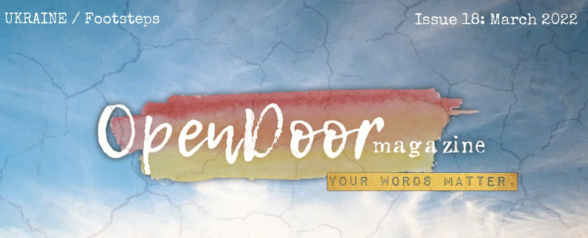Published by OpenDoor Magazine, March 2022
The train out from the city seems headed toward weather; a curve offers a full view of clouds piled up by tumultuous winds. They must be dark beneath, but from here are tossed into the creamy light of a setting sun: a down comforter or feather pillows punched up by a playful child.
The clouds darken as she nears  her station, with zigzags of lightning; she begins to worry about the walk home. Eight long blocks, almost a half-mile. After deskbound days, it is usually welcome exercise, and unless the weather is truly dreadful she always walks. Unlike the twenty-somethings in the office, she wears sensible shoes, and there is still a spring in her step.
her station, with zigzags of lightning; she begins to worry about the walk home. Eight long blocks, almost a half-mile. After deskbound days, it is usually welcome exercise, and unless the weather is truly dreadful she always walks. Unlike the twenty-somethings in the office, she wears sensible shoes, and there is still a spring in her step.
Tonight is a mild late-October evening, Indian summer after a first frost, and a sprinkle won’t deter her. On the other hand, one wouldn’t want to be caught in a drenching downpour. If it’s really threatening when she leaves the train, a cab might be an alternative—but in a suburban station at this time of day, cabs are scarce.
Once out of the shopping area near the station, she will have the park on her right the whole way. Handsome houses line the left, most built in the 1920s, many big enough to have once had live-in cooks’ quarters. That era is long gone, but it remains a middle-income neighborhood that prides itself on its racial diversity. She bought here five years ago primarily for the bargain price, but she enjoys telling the white male lawyers at the office that she lives in a mixed community. She scolds herself for not having made more effort to know that community.
Moments like this prod that self-awareness: She would be more confident walking into a looming storm if she knew some of the neighbors along the way, who might offer haven from a sudden blast. Despite invitations to several summer block parties and community meetings, she has procrastinated. Busy-ness and a backlog of reading are, she knows, rationalizations for her insecurity with social interactions.
Relief: Reaching her station, she sees that her worry has been unnecessary: There may have been the briefest of showers here moments ago, but the rain-laden clouds are clearly moving off to the east.
As always, the first block is bright and busy. On one side is the Higgly-Piggly, where she shops once or twice a month; living alone, she doesn’t cook much for herself. Next door is the pizzeria, which delivers, and then the package store and the bakery. Across the street are smaller shops, few of which she has patronized. Not that she’s inordinately frugal, but shopping has never been a pastime, and most of those shops are aimed at the population on the far side of the park, neighborhoods distinctly ungraced by integration and diversity.
She strides diagonally across the intersection, suddenly out of the bright light and stepping onto the sidewalk, the park on the opposite side of the street. It was originally all meadow, but in the 1920s a wooded barrier was planted, thirty yards wide. They were mere saplings then; today it is a thin forest along the margin.
She has thought that she should walk across the park some sunny afternoon, or perhaps drive, to be an informed citizen, to know more about a totally different neighborhood, Black and poor. That she has not done so, she thinks, is not a matter of prejudice; she exchanges friendly greetings, when their paths cross, with the families on her side of the park: Black, Asian, probably Latino, white. On the other hand, the husbands and wives in those houses are not among the commuters with whom she shares inclement-weather rides.
She has started the third block when she becomes aware of the footsteps. Certainly not the staccato of a woman’s heels—and few women could even keep up with her brisk stride, let alone gain on her.
She is not timid, nor easily frightened, but it is a habit of urban self-preservation to see who belongs to the footfalls and how far back he is. Probably someone coming home with a loaf of bread. Perhaps even a neighbor from her street, which is still five blocks ahead. She doesn’t know everyone on her block, but she would recognize most of them.
Just ahead a large house shows light in the downstairs front rooms. At its front walk she pauses and turns to face the house, allowing herself a glimpse behind. She waves at the house as though greeting a neighbor, subtly signaling the man behind that she has friends here looking out at the street and looking out for her.
He is perhaps forty paces back. Wearing a grey hoodie of the sort favored by young Black men; probably from across the park. In the dark between streetlights she can make out nothing of his features under the hood.
If she had gone to the last block party she might actually know the occupants of this house, and might now go to their door and explain her anxiety, but she has no idea who they are. She waves again to her hypothetical window-watcher and starts up the street again, picking up her pace.
Immediately she thinks better. She should have walked up and rung the doorbell, even if she didn’t know them, and made some pretext for lingering until the man was well up the street. Too late: She cannot walk back now without coming face-to-face.
The houses the rest of the way up this block have dark front windows. There are pools of light in the rear doors—that’s where the kitchens are in most of these houses—but those are accessible only by way of very dark driveways.
A car comes from behind and passes before she can think about it. There has been no other traffic; the street is far from being a thoroughfare. But if another car comes along, she should step out to stop it.
And then say what? That there is a man in a hoodie sharing the sidewalk with her? Well, why not? She could feign a sprained ankle and ask the driver to take her home.
Suppose such a car would not stop? If the man in the hoodie had designs on her, he would surely then rush up, hoping to frighten her into the pitch-black park across the street, where she could expect no further help.
It seems worth the risk. She will step out as close as she dares into the path of the next car. Even if the driver swerves around her, afraid to stop when accosted by a woman in the street, he might use his cell phone to call the police. And she must avoid at all costs being spooked across the street into the park.
Cell phone! Why hasn’t she thought of that? It is hard reaching into her purse without slowing, but she gets it into her hand and flips it open. If she can dial 9-1-1 without stopping, she can have it at her ear in a moment, ask urgently for help, get this over with. She tries to visualize the keys: 9 in the lower right, 1 diagonally across and up; where is the “call” button? She dares not stop long enough to look down and dial. Blind people learn to make their fingers sentient; why are hers so unperceptive?
The footsteps are closer. She resists the impulse to run. He is gaining on her at a brisk walk, and could surely run her down. There are still no cars. She rehearses in her mind again a quick step into the street, waving her arms like a windmill, then making a supplicating gesture.
He cannot be fifteen paces behind her now; his steps sound like thunder. She can’t manage a call to 9-1-1 until she reaches a streetlight. She looks again at the houses ahead, hoping for a pool of light that she can reach, light suggesting people inside to whose doorstep she can turn; worst case, occupants who will hear if she screams.
Perhaps he means her no harm. She might turn, smile, say good evening and invite him to play through, the way she’s told one does on a golf course.
Across the street, at the start of the next block, is a vacant house. Foreclosed and sold a month ago, it is boarded up against vandals or those who might use it as a drug den or homeless shelter. Perhaps, she thinks hopefully, he is merely headed there.
The streetlight in front of that house is out. She noticed it two nights ago, and should have reported it. It is a huge Stygian danger zone.
He speaks. “Stop there, lady. Don’t turn around. I have a gun. If you turn around and see my face, I will have to kill you.”
Does he really have a gun drawn? If so, a passing motorist would surely notice it—if there were any.
“I saw you take the cell phone out,” he adds. “Put it on the ground.”
She looks down, fingering it.
“Don’t even think about dialing it, lady. Put it down, I said, or I will have to use the gun.”
She avoids bending over, presenting her backside, and instead half-squats, sets the phone down, and straightens quickly. She must listen to the voice, be able to identify it. It is unfamiliar; surely no one she knows, not one of her kind. Is there an accent?
“Now step out of your shoes, lady.”
“What?” she asks over her shoulder.
“Dammit, I told you not to look back. I really don’t want to kill you. Just kick them off.”
Her shoes today are almost flats. Heels might be more useful for fending off an attacker, but any shoes might be a defense weapon. Reluctantly, she kicks them off.
“Now step forward five steps, lady.”
She hesitates, then takes a step.
“I said five, lady. Big steps. Hurry up, for God’s sake.”
He must also be thinking about a passing motorist. She takes four more steps, and hears him step forward to pick up her shoes and her cell phone. He must have to bend over, not keep the gun trained on her. She has a fleeting urge to turn around, kick him down while he is off balance. But it would take several strides; she would be kicking barefoot. And he says he has a gun.
Two scuffing sounds in the street behind suggest he has thrown her shoes toward the park. She manages not to look back.
“Now, lady, I want you to open your purse, look inside, and tell me how much money you have there. I don’t want your credit cards. Just cash. Count it out.”
She takes out her wallet, peers into the darkness, fingering the bills.
“Out loud.”
She does as told. “Three twenties. Two tens. A five. Some ones.”
“Good. That’s enough to make the trip worthwhile. Drop it on the ground. Don’t scatter it; drop it straight down.” She does, half-crouching again. “Now take five steps forward again.” She does.
“Good. Now five steps more.”
She hesitates.
“Move!”
She does. She hears his step, imagines him bending over to retrieve the bills, thinks again of martial-arts kicks she has seen.
There is silence, then a cascade of footfalls. She tenses, whirls, ready to strike out, scratch, knee. But she realizes that he had tiptoed backward, and is now running across the street into the park. She is just in time to see the hoodie disappear into the inky forest.
Unsure for a moment whether to feel relieved or angry, she hurries the last blocks to her house, stockings quickly torn, feet bleeding. A car comes just as she steps into her driveway. It is too late; no point in flagging it down.
She lets herself in, turning on every light, ignoring the cat that comes to rub against her leg asking for attention. She goes to the kitchen. She must call the police. She must go upstairs to the computer, hoping it will as advertised tell her where the cell phone is now, and help the police track down the hoodie man.
And she must get to know more of her neighbors.
But before any of that, she reaches down the Scotch. Her hand shakes.
-End-
Published by OpenDoor Magazine Issue 18, March 2022






Excellent! Thanks! Great read!
Well done! I’m afraid that I had the advantage of a visual in my mind of the setting which made it all the more real. I hope all is well at Seabury.